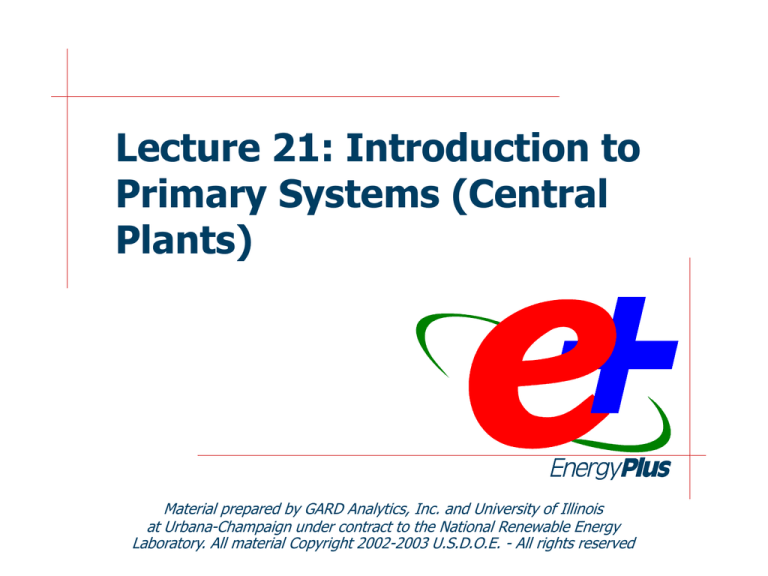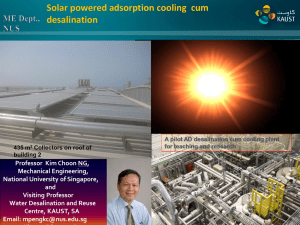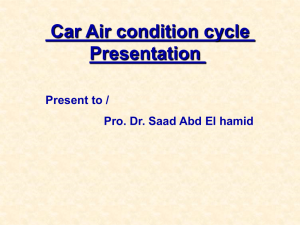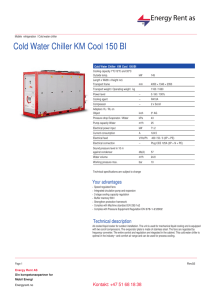
Lecture 21: Introduction to
Primary Systems (Central
Plants)
Material prepared by GARD Analytics, Inc. and University of Illinois
at Urbana-Champaign under contract to the National Renewable Energy
Laboratory. All material Copyright 2002-2003 U.S.D.O.E. - All rights reserved
Importance of this Lecture to the
Simulation of Buildings
Primary systems provide hot and chilled
water for the secondary systems as well
as other energy sources that are
needed by the building
Some knowledge of the primary
systems (central plants) is required to
accurately simulate buildings and to
understand what the model input
parameters are
2
Purpose of this Lecture
Gain an understanding of:
Basic information about primary plants
(central plants)
Interconnection between primary plants
and the rest of the building
3
Cooling Equipment
Chillers: Compression-Based and
Absorption
Heat Pumps
Rooftop/DX Packaged Units
Thermal Energy Storage (Water and Ice)
Compression-Based Liquid
Chilling Systems
Compression Chillers and Heat Pumps both work on
what is commonly referred to as a “vapor
compression cycle”
Thermodynamic cycle through which refrigerant goes
Refrigerant is enclosed within cycle components
Components
Condenser
Compressor
Evaporator (aka Liquid Cooler)
Expansion Valve
Primary and secondary fluids (refrigerant, water, etc.)
5
Compression Cycle
Typical compression cycle diagram:
Condenser
High
Pressure
Low
Pressure
QC
Compressor
Work
Expansion
Valve
Evaporator
QE
6
Compression-Based Liquid
Chilling Systems (cont’d)
Cycle Details
High pressure side: from compressor outlet through
condenser to expansion valve inlet
Low pressure side: from expansion valve outlet through
evaporator to compressor inlet
Utilize the fact that the boiling point of the refrigerant
changes as the fluid pressure changes: lower pressure
means a lower boiling temperature
Refrigerant picks up heat in the evaporator (refrigerant
evaporates) because the chilled fluid temperature is higher
than the refrigerant temperature
Refrigerant rejects heat in the condenser (refrigerant
condenses) because condenser fluid temperature is lower
than refrigerant temperature
Compressor drives the cycle by compressing the refrigerant
through the addition of work
First Law of Thermodynamics
7
Chillers/Heat Pumps for
Conditioning
Cooling: Normal operation mode
Goal is to provide cooling at the evaporator where
there is chilled water or air that is produced
Coefficient of performance (COP) equal to cooling
achieved at the evaporator over the work required at
the compressor
Heating: Reverse operation (heat pumps)
Goal is to provide heating at the condenser where
there is hot water or air that is produced
Typically this requires a reversal of refrigerant flow
Coefficient of performance (COP) equal to heating
achieved at the condenser over the work required at
the compressor
8
Chillers/Heat Pumps for
Conditioning (cont’d)
Efficiency and Energy Issues
Work is required because we are trying to get heat to flow in a
direction that is counter the natural flow of heat (natural would be
from higher temperature to lower temperature)
COP is generally greater than 1.0 so we get more kW-h of cooling
or heating than electric kW-h that we put into the compressor
Performance (and COP) of the system is highly dependent on the
fluid temperatures that the condenser and evaporator are in
contact with
Lower evaporator temperatures result in lower COP
Higher condenser temperatures result in lower COP
More extreme temperatures lower COP and can lower available
capacity
Temperature relation to performance can be a hindrance to the
system or a potential advantage
Heat pump may struggle and require more energy as outside
temperatures become more extreme
Presence of a more moderate/constant temperature source can keep
system running efficiently (e.g., ground)
9
Chillers/Heat Pumps for
Conditioning (cont’d)
Chiller vs. Heat Pumps—what’s the
difference?
Difference in system components: none
Chillers are generally cooling only device and are
used to produce chilled water for cooling coils
(size range can be quite large)
Heat pumps can provide both heating and cooling
and are typically smaller in size (often residential
units)
Heat pumps are typically compression cycle only
and almost all use electric energy as input
Chillers can use various cycles and may actually
use other energy sources as the system energy
input
10
Condensers
Purpose: to reject heat from refrigerant to
surrounding environment, condensing the refrigerant
from a (superheated) vapor to a (subcooled) liquid
Condenser is really a “heat exchanger” which
transfers energy from one fluid stream to another
without mixing the two streams
Water-Cooled Condensers
Heat exchanged with water which is circulated to another
“component” (ground, lake, pond—natural or constructed,
river, cooling tower, etc.) as closed or open loop
Condenser temperature depends on water source
temperature
11
Condensers (cont’d)
Air-Cooled Condensers
Heat exchanged with outdoor air
Fans required to improve heat transfer
Condenser temperature linked to outside air dry bulb
temperature
Evaporative Condensers
Heat exchanged sensibly and latently with outdoor air
Fan and pump required: fan to circulate air through unit,
pump to circulate water
Added evaporation process increases performance
Condenser temperature linked to outside wet bulb
temperature (less than or equal to dry bulb)
Condenser water and evaporative water kept separat
12
Condensers (cont’d)
Cooling Towers
Similar concept as evaporative condensers
Condenser water “open” in the tower
Some water evaporates, requiring make-up
water
Some systems eliminate the fan
requirement
13
Condenser Examples
14
Condenser Examples (cont.)
15
Digital images on this slide courtesy of:
Lisa Fricker, Graduate Student, UIUC
16
Condenser Examples (cont.)
17
Evaporators (Liquid Coolers)
Purpose: to absorb heat in the refrigerant
from the surrounding environment,
evaporating the refrigerant from a liquid (or
liquid/vapor mixture) to a (superheated)
vapor
Evaporator is also a heat exchanger
Evaporator can be a cooling coil itself or a
refrigerant (DX or direct expansion coil) to
water heat exchanger to the chilled water
loop
18
Heat Exchangers
Heat Exchanger Types (largest to smallest):
Shell-and-Tube
Plate/Plate-and-Frame
Tube-in-Tube
Shell-and-Coil
Heat Exchanger Issues:
Larger exposed air means largest UA (more heat
transfer)
Fouling can affect performance over time
(maintenance issues)
Interior and exterior fins on coils
19
Compressors
Purpose: to compress the refrigerant vapor to a
higher pressure (also increases the temperature)
Mechanical device: power input converted to
mechanical energy
Types of Compressors:
Positive-displacement: “squeeze”—increase pressure be
decreasing vapor volume
Reciprocating
Rotary
Scroll
Trochoidal
Dynamic: “spin”—increase pressure by transferring angular
momentum, momentum converted to pressure increase
Centrifugal
Centrifugal tend to be used in larger systems
20
Compressors (cont’d)
Motor Types
Open: motor and compression chamber
separated via shaft link
Hermetic: motor and compression chamber
same, motor shaft and compressor
crankshaft integral
Semi-hermetic: bolted construction allows
field service
21
Compression Cycle: Big
Picture
Direction of heat transfer
Cooling Tower
Expansion
Valve
Condenser
Compressor
Evaporator
Air System
To Zones…
Cooling Coil
22
Absorption-Based Liquid Chilling
Systems
Concept
Compression-based chillers use electrical energy (work) to produce
heating or cooling (in the opposite direction of natural energy flow)
Absorption-based chillers use mixture/solution chemistry and a heat
source to produce heating (reverse cycle—also called heat
transformer) or cooling (forward cycle—more common)\
Absorption-based systems are most effective when a “free” or very
inexpensive source of heat is available
Solar energy
“Waste” heat
Heat source must be high enough quality (temperature) to
drive system
No compressor or other large rotating mechanical equipment
needed
Two “refrigerants”—primary and secondary (absorbent)
Primary—usually water
Secondary—usually ammonia or lithium bromide (LiBr)
23
Absorption Chillers (cont’d)
Components
Generator (desorber)—high pressure side
Condenser—high pressure side
Evaporator—low pressure side
Absorber—low pressure side
Heat Exchanger
Pump
Expansion valve/flow restrictors
Refrigerants
24
Absorption Chillers (cont’d)
Cycle Details (LiBr system)
Pure water (vapor/liquid) in the condenser and evaporator
Primary refrigerant (water) and absorbent mixtures of
varying concentrations in generator and absorber
Weak liquid solution is introduced into the generator along
with heat from some source
Generator process: boils water out of solution accomplishing
two things
Pure water vapor is sent over to condenser side of chamber
Strong(er) solution (liquid) is sent to absorber
Water vapor in condenser is converted to liquid (condensed)
by the removal/rejection of heat
25
Absorption Chillers (cont’d)
Cycle Details (LiBr system, cont’d)
Condensed water is pushed to the evaporator as a result of the pressure
difference/gravity
Liquid water in the evaporator is boiled off with the addition of heat at low
temperature/pressure
Water vapor boiled off from evaporator is sent to absorber
Absorber: Water vapor condenses (potential heat rejection) and gets
reabsorbed into the water-LiBr solution, weakening the solution
Absorber sends weakened solution back to generator where cycle starts
over again
Pumps used to send solution from absorber to generator and to circulate
liquid water over evaporator coil
Heat exchanger used between lines connection generator and absorber—
reduces heat addition needed in generator (improving efficiency)
Goal is cooling at the evaporator (forward cycle) or heating at the generator
(reverse cycle)
Many slight variations on this basic cycle
26
Absorption Chillers (cont’d)
Performance Issues
Capacities typically range from 180-almost 6000 kW (big!)
though smaller units on the range of 18-35 kW available
internationally
Typical COP values are much lower than for compression
cycle chillers: 0.7-0.8 or lower is common
Low COP not necessarily a problem if heat source is free:
COP = Usable cooling/energy input
Other Issues
Is a heat source available that can be used?
Concerns about water in contact with metal inside
absorption system (rust formation)
Potential toxicity of absorbent
Noise—far less than a compression cycle chiller
27
Thermal Energy Storage
Concept
Produce and store energy for use during another time
Initially, this was as simple as cutting ice blocks from Lake
Michigan and storing those until summer
Now, energy storage is produced during off-peak hours when
energy costs are lower
Overall dollar effect is a reduction in the conditioning costs for the
buildingprimary (or only) benefit is economic
Reduction in cost per kW-hr and reduction in demand costs
Costs based on type of power plants running
Cost of start-up and shutdown of power plants
Mainly an issue for industrial customers, usually used for cooling
Utilities have in the past actually paid (in part) for systems
Reduced demand reduces need for new power plants
Shift of electric load uses power that might not otherwise be
used (hydroelectric, nuclear, etc.)
28
Thermal Energy Storage (cont’d)
System Types
Tempered Water Storage
Storage of hot or cold water in a large tank above or
below grade
Water is kept stratified, taking advantage of density
differences of water at different temperatures
Inlet diffusers must be designed to avoid mixing
Some energy transfer does occur between hot and cold
sides
Water in tank can serve as emergency water source in
case of fire
Water temperatures for cooling same as for standard
chiller only system
Large tank needs large space, tank losses
29
Thermal Energy Storage (cont’d)
System Types (cont’d)
Ice Storage
Storage of cooling energy in the form of ice
Latent heat of solidification allows large amount
of energy storage in a much smaller area than a
water system
System types:
Ice-on-coil outside melt (obsolete)
Ice-on-coil inside melt
Encapsulated ice (ice container)
Ice harvester
Ice slurry
30
Thermal Energy Storage (cont’d)
Efficiency Issues (Ice Systems)
Process for producing ice less efficient than chilled
water production (temperatures required for
making ice are much lower, resulting in lower
efficiency/COP and capacity of chiller)
This may be offset somewhat be reduced
condenser temperatures due to cooler outdoor
conditions at night
Systems can produce lower supply air
temperatures, reducing the flow rates needed to
provide same cooling (which lowers fan energy)
Do ice storage systems save dollars and energy?
31
Thermal Energy Storage Controls
Full Storage (discharging)
Minimizes on-peak energy consumption, maximizes
energy consumption shift
Largest storage requirements and perhaps largest
chiller (and initial costs)
Probably largest potential savings on operating costs
Partial Storage (discharging)
Types:
Chiller priority: chiller runs during on-peak only up to
some set demand limit, ice meets all other needs
Ice priority: storage meets demand up to some limit
and chiller is turned on if the demand is higher than the
limit
Some shift of energy consumption to off-peak, also
savings on demand costs
Smaller chiller requirements than full storage or no
storage
32
Thermal Energy Storage Controls
(cont’d)
Charging Strategies
Zero prediction—chiller charges system at
its capacity as soon as off-peak period starts
“Optimal” strategies
Delay start of charging to take advantage of
presumably cooler outdoor air in early morning
hours
And/or run chiller at less than full capacity at
whatever its optimal fraction of full load is
33
Heating Equipment
Boiler
Furnace
Heat Pump
Heating Equipment
Electric resistance heating
Heat pump in heating mode
Solar panels
Boiler
Water
Steam
same basic principle,
just a different fluid
Furnace (air)
35
Boilers
Definition: equipment whose sole
purpose is to provide hot water or
steam for various uses within a building
Size (capacity) range:
15 kW 30+ MW
Fuels: coal, wood, fuel oil, (natural) gas,
electricity
36
Boiler Uses
Steam:
Heating coils (reheat, preheat)
Hot water heat exchangers
Absorption cooling
Laundry
Sterilizers
Water:
Heating coils (reheat, preheat)
Domestic hot water
37
water
water
water
water
Boilers: Basic Layout
stack/flue/ Goal:
chimney
Try to get most
efficient transfer
of heat from
flue gas
(combustion
products) to
water
burner
air/fuel
mix
38
Boiler Example (continued)
Digital image on this slide courtesy of:
Lisa Fricker, Graduate Student, UIUC
39
Boilers: Types
Dry Base/Back
Wet Base/Back/Leg
Base (bottom), back (with respect to multipass boilers), leg (top and sides)
Condensing
Flue gas condensing due to low return
temperature of water
More efficient, but potential for rust greatly
increased
40
Boilers: Efficiency
Fuel Boiler (combustion efficiency)
Efficiency = (input – stack loss) / input
Non-condensing 75-86%
Condensing 88-95+%
Electric Boiler (overall efficiency)
Efficiency = output / input
Range of efficiencies 92-96%
41
Furnaces
Heats air indirectly
Combustion products do not mix with
circulated air dangerous
Fuels:
Natural gas (most common)
LPG (liquefied petroleum gas)
Oil
Electric
42
Furnaces (continued)
Sizes:
Residential units (smallest)
Commercial (44 600+ kW)
Generally smaller than boilers
Various configurations:
Combustion systems
Air flow variations (single/multi-pass)
43
Furnace
(AHU)
Example
44
Boiler/Furnace Stack
45
Furnace Efficiency
ANSI/ASHRAE Standard 103
Annual Fuel Utilization Efficiency (AFUE)
Usable Heat Output
AFUE
Fuel Input
AFUE includes: latent and sensible losses,
cyclic effects, infiltration, pilot burner
effects, and losses from a standing pilot
when furnace not in use
AFUE 78-80% for non-condensing, 90+%
for condensing
46
Big Picture Review
Zone (Loads)
mix box
air
supply fan
surroundings
Secondary
System
heating coil
pump
A Building
and its
HVAC
System
boiler
Primary System
cooling coil
pump
chiller
pump
cooling
tower
47
Summary
Primary systems convert one form of
energy (fuel, electricity, etc.) to thermal
energy
Chillers/heat pumps are used to provide
cooling (direct expansion or chilled
water)
Boilers are used to provide steam or hot
water for heating coils
Furnaces are used to provide hot air
48








